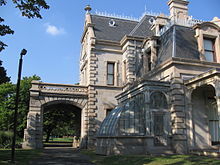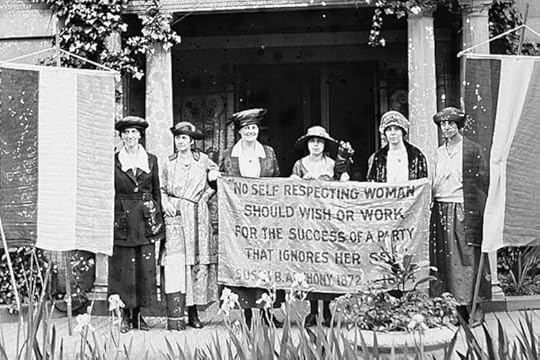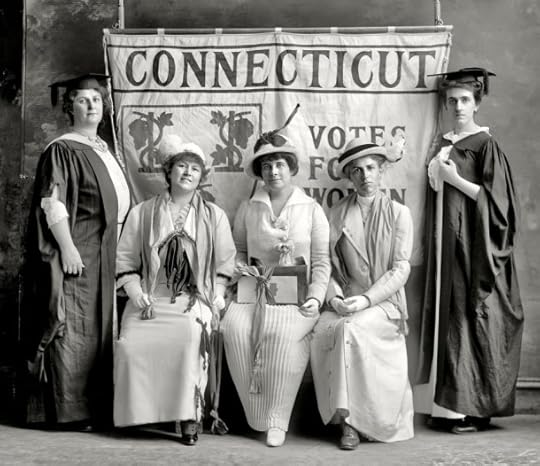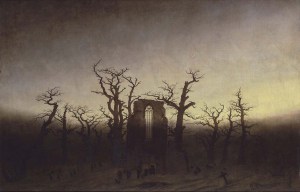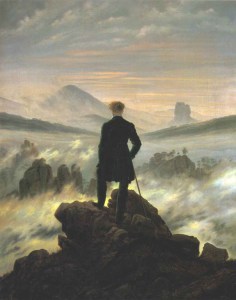Gail Ingis's Blog, page 6
January 10, 2019
Get serious about skin care

beautycounter cleanswapheader-these are some of the products available separately
For the sake of all of us, our good health and wise choices, I am doing my blog about skin care products that have no harsh chemicals.This information was taken from a New York Times interview with the founder of beautycounter.com.
In 2011, Ms. Gregg Renfrew founded beautycounter (one word), manufacturer of cosmetics and personal care products. But instead of creating just another makeup brand, Ms. Renfrew made several unconventional decisions.
First, she made a list of more than 1500 potentially harmful ingredients that she vowed never to use in her products. Next, she turned the conventional business model on its head, shunning department stores in favor of a network of independent consultants. Finally, she embarked on a campaign to introduce new regulations to the personal care industry, noting that the last law governing it was passed in 1938.
How did Beautycounter get going?
I watched “An Inconvenient Truth” and had become impassioned with the environmental health movement. I was washing my children with a natural foaming oatmeal body wash by a name brand, but when I went on the Environmental Working Group’s database, it rated it an eight out of nine for toxicity. I thought I was using natural oatmeal body wash, and in fact I was putting toxins on my babies. I was just outraged. And I became truly obsessed with this.

Mini color intense lipstick vault
At the same time, I was looking at where direct to consumer was going, and where I saw the biggest white space was in beauty. No one had pioneered meaningful change in that industry. It took me a couple of years to concept the idea, the selling model, create the products from scratch. I went in thinking that we could just use white-label products and change a few ingredients. That was not the case.
You’re very focused on bringing more regulation to your own industry. That’s unusual.
Most people still believe that the Food and Drug Administration is protecting them in terms of personal care products. And most people believe that the products on the market are safe. But the F.D.A. is not necessarily screening ingredients for safety, which is very different from the food industry. The F.D.A. can be protective of the consumer in certain industries, but in our industry, we are woefully under regulated, and they don’t have the power to recall products. And this is one area where you have bipartisan support. Everyone agrees that we need to update the laws. It’s been 80 years now.
So what ingredients do you use and not use?
There are mostly natural ingredients that are safer, but some natural ingredients are not safe. There are heavy metals in the ground that are not safe for your health, and there are perfectly benign man-made ingredients. We have something called the Never List, which is a list of ingredients we chose not to formulate with.
To get safer products into the hands of everyone. Learn More
http://beautycounter.com/gailingis
Taken partly from an interview with Ms. Renfrew by David Gelles at the New York Times. Gelles is the Corner Office columnist and business reporter. Follow him on LinkedIn and Twitter. @dgelles
It’s always Christmas in this camp!

December 27, 2018
It wasn’t always a museum!
Unlike the Metropolitan Museum of Art, this building wasn’t always a museum, it was the country home, first for the Lockwood’s, then the Mathew’s.
 Lockwood–Mathews Mansion is a Second Empire style country house, now a museum, at 295 West Avenue in Norwalk, Connecticut. It was built in 1864-68 by railroad and banking magnate LeGrand Lockwood. The 62-room 44,000 square feet mansion was listed on the National Register of Historic Places and was declared a National Historic Landmark in 1978.
Lockwood–Mathews Mansion is a Second Empire style country house, now a museum, at 295 West Avenue in Norwalk, Connecticut. It was built in 1864-68 by railroad and banking magnate LeGrand Lockwood. The 62-room 44,000 square feet mansion was listed on the National Register of Historic Places and was declared a National Historic Landmark in 1978.
It has been described as “one of the earliest and finest surviving Second Empire style country houses ever built in the United States.” It sits at 295 West Ave., in Mathews Park, where the Stepping Stones Museum for Children is also located.
The estate, then called “Elm Park,” was built by LeGrand Lockwood, who made his fortune in banking and the railroad industry. Construction began in 1864 just west of the Norwalk River in Norwalk and was completed four years later. Designed by European-trained, New York-based architect Detlef Lienau, the mansion “is considered his most significant surviving work,” according to the association. Both American and immigrant artisans worked to construct and decorate the house.[6] Prominent New York decorating firms, including Herter Brothers and Leon Marcotte were contracted to furnish the mansion’s interiors. Financial reversals in 1869 and Lockwood’s death in 1872 resulted in loss of the estate by Lockwood’s heirs. The Mathews purchased in 1874 and maintained the country home until 1938 and was sold to the city of Norwalk.
East side of the home seen from the south, showing porte-cochere and greenhouse
“The Museum’s mission is to conserve the building while creating educational programs on the material, artistic and social culture of the Victorian era,” according to the museum organization’s Web site. Built in 1864-68, it is an early example of the style used by wealthy New York City elites such as the Vanderbilt’s in building their Gilded Age mansions later in the 19th century, and set a new standard for opulence.
In a decades-long Christmastime tradition, interior decorators deck out about a dozen rooms in the mansion with holiday decorations. An annual “community celebration” is held in December with Christmas music, refreshments and a Santa Claus. In 2007, 10 interior decorators volunteered their services and materials for the event.
The museum has hosted an annual antique show since 1978. In 2006 the show was held the last weekend in October and attracted dealers from Ohio and Pennsylvania as well as Connecticut.
The home was used as a filming location for the 2004 remake of The Stepford Wives. Paramount Pictures paid the museum $400,000 to paint its central rotunda. The studio also left behind some large paintings (in essence, theatrical pastiches), which serve to emphasize the dramatic size of the rotunda. As a result, the walls look fresh and decorated, and will remain protected until further funds become available for proper, curatorial restoration of the original damaged surfaces.[8]
The mansion was also featured in the movie House of Dark Shadows.
On December 21st,
 with mistletoe and holly, the trustees celebrated the volunteers who are doing a fantastic job serving as workers for the operations and docents. While the trustees, of which I am one as well as the art curator, work for the preservation and protection of this precious part of history in the United States. Other dedicated people are here below who offer their services unsolicited!!! Ladies, Danna of The Silk Touch and Marcia, interior designer, and two gentlemen, Mike, and David Westmoreland.
with mistletoe and holly, the trustees celebrated the volunteers who are doing a fantastic job serving as workers for the operations and docents. While the trustees, of which I am one as well as the art curator, work for the preservation and protection of this precious part of history in the United States. Other dedicated people are here below who offer their services unsolicited!!! Ladies, Danna of The Silk Touch and Marcia, interior designer, and two gentlemen, Mike, and David Westmoreland.If you want to be part of this museum, we always appreciate volunteers. Just give us a call, ask for Melissa. 203-838-9799 ext. 115.

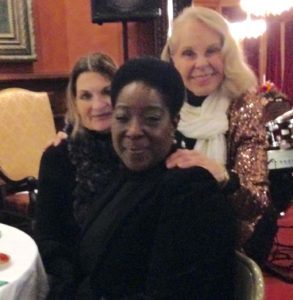



December 20, 2018
Celebration!

 Come now Christmas morning, white snow falling, the star in the night sky gone, but the King remains, always in our hearts. The celebration of love, forgiveness, and hope resounded at the Black Rock Church in the songs of this special time of year. Everyone sings and rejoices, no matter who you are, all love the music, the lights, the smiles on everyone’s faces.
Come now Christmas morning, white snow falling, the star in the night sky gone, but the King remains, always in our hearts. The celebration of love, forgiveness, and hope resounded at the Black Rock Church in the songs of this special time of year. Everyone sings and rejoices, no matter who you are, all love the music, the lights, the smiles on everyone’s faces.
For your viewing and listening pleasure








December 13, 2018
In the 19th Century… Women’s Suffrage
It began around 1840 here in the USA. Women’s suffrage. That’s the same year of Ireland’s pototo famine. Women had their own famine, lack of freedom, poor job situations, lack of education for children who had to work to help their families. Working conditions shamefully were like rat holes. Women have been fighting for their freedom for almost two centuries, the vote finally came in 1920, but the fight continues.
I’m still writing my book, the Unforgettable Miss Baldwin. Allie, bless her heart, has a passion to see women get the vote, and have rights, be free. She’s working with Susan B. Anthony and the many women fighting for the same. Of course no resolution happened in her day, but she fought alongside the many women working to change the way women were treated. The resolutions below are actually from Wikipedia’s 20th century list.

Dragged off to jail for participating in a freedom fight.
Those who fought got dragged off to jail. Some went on hunger strikes and were forced fed. Unbelievable. This is not a history lesson, but some of the stories read like unsolved mysteries.
If you remember Gloria Steinham, another fighter for women’s freedom, along with Billy Jean King and others, we are still fighting.
Resolutions 1325 and 1820 and CEDAW share the following agenda on women’s human rights and gender equality:[6]
Demand women’s participation in decision-making at all levels
Rejection of violence against women as it impedes the advancement of women and maintains their subordinate status
Equality of women and men under the law; protection of women and girls through the rule of law
Demand security forces and systems to protect women and girls from gender-based violence
Recognition of the fact that distinct experiences and burdens of women and girls come from systemic discrimination
Ensure that women’s experiences, needs and perspectives are incorporated into the political, legal and social decisions that determine the achievement of just and lasting peace.
https://en.wikipedia.org/wiki/Women%27s_suffrage_in_the_United_States#Emergence_of_the_women’s_rights_movement

A work of art

December 6, 2018
THE BILTMORE HOUSE
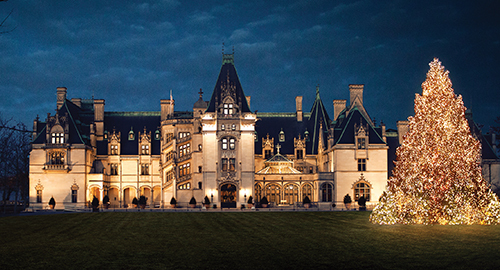
A couple of years ago, my husband, Tom Claus and I spent three fantastic days in Asheville, NC, home to the Biltmore House. The place is awesome. It is the largest privately-owned home in the United States. The 250-room mansion features 33 family and guest bedrooms, 43 bathrooms, 65 fireplaces, three kitchens, an indoor swimming pool with electric underwater lights and a bowling alley. We took an architectural tour and got to see behind the scenes.
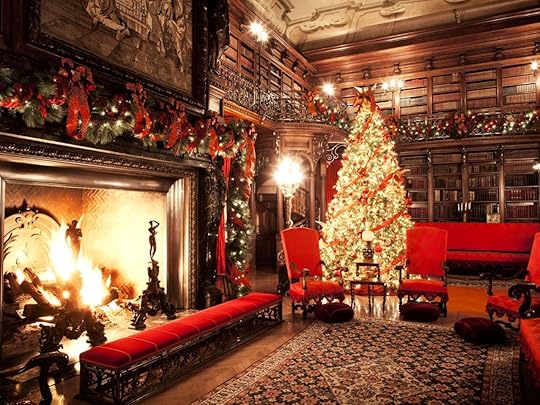
A cozy room at the Biltmore
George W. Vanderbilt III knew what he was doing. His inheritance was less than his siblings, but he managed well. He called in the prominent New York architect, Richard Morris Hunt, who had previously designed houses for various Vanderbilt family members, to design the house in the Chateauesque style, using several Loire Valley French Renaissance architecture chateaux, including the Chateau de Blois as models. The house has similar features as France’s Chateau Chambord. He closely copied the staircase of the Chateau de Blois. The estate includes its own village, today named Biltmore Village, and a church in town, known today as the “Cathedral of All Souls.”

Christmas entry Hall
The collections at the house are priceless furnishings and artworks. The house is equipped with every convenience from elevators to refrigerators. The surrounding grounds, designed by prominent landscape architect, who also designed New York’s Central Park, Frederick Law Olmsted, are impressive, encompassing 125,000 acres of forests, farms and a dairy, a 250-acre wooded park, five pleasure gardens and 30 miles of macadamized roadways.
Biltmore House was his country home, a respite away from city life, and a place for his mother when she visited the hot springs in the area. It became an American icon. Unfortunately, after his death and the passing of his wife, Edith Vanderbilt, it became run down, like other historic sites. Developers offered to buy 12,000 acres to build subdivisions. But George’s great-grandson, William A. V. Cecil, Jr. thought not. By the 1950’s Cecil had started a restoration project. The treasure was to remain with the Vanderbilt family.
Jan Aertsen van der Bilt had emigrated to this country from Holland around 1650. They prospered as farmers on Staten Island, New York and lived modestly. It was only during the lifetime of Cornelius Vanderbilt (1794-1877) that the family name became synonymous with extraordinary wealth. It was especially important to me to visit this architectural wonder, not only architecturally, but to follow the trek of the Vanderbilt family. My affiliation with the 1867 Lockwood Mathews Mansion Museum in Norwalk, CT connects me to the Vanderbilt name through the business relationship of Cornelius (aka as the Commander) and LeGrand Lockwood, same as the mansion mentioned above.

eBook, print book, audio book

November 29, 2018
Recent Ride to Raleigh

I 95 South–day before Thanksgiving (no one was hurt)

Claus and Franklin family at the Thanksgiving table.
The day before Thanksgiving, on our ride to Raleigh, this wasn’t the only incident causing a mega traffic mess. There were other accidents, and thousands of cars and trucks going south. We were in the middle, our muddle, should have left before sunup. Our kids, coming from Atlanta had similar traffic. Never before have I seen such a mess, and never again. I will always leave before the sun has risen. We passed a billboard that said, Would you rather fly?
Nah, flying isn’t the answer. The airports have their own messes. My best, stay home, at least on the biggest travel days of the year. Home is our favorite vacation spot. Like right now, by a cozy fire, roasting marshmallows, and

Grandma’s veggie soup specialty
delicious hot soup on the stove filling the house with aromas to make your mouth water, me writing my book and Tom writing science. It’s toasty in this place. A perfect place to be.
Our Thanksgiving home away, the Raleigh Renaissance Hotel, is surrounded by high-end shopping. Just walk out the hotel door, and you have scads of shopping choices, even Target, in the middle of all these gorgeous shops and boutiques. We saved the shopping for the day after Thanksgiving, which couldn’t come soon enough. I have some of the shopping in pictures.
We found a delightful men’s shop that’s also right here in Greenwich, Bonobos. Anthony was adorable while helping us, he fell in love with my green bling jacket, and here he is modeling it. Everyone in the store stopped and stared. Now showing off his bling shoes, me hiding behind. Anyone know where we can find Anthony a bling jacket?
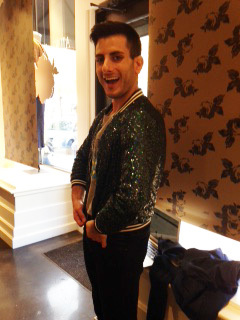

Anthony showing off his bling shoes and Gail in her bling jacket

Renaissance Hotel lights not on yet.


Print book, eBook, Audible

November 8, 2018
Writers & Painters Unite!

Delivered!
The letters of artist Robert Genn have been coming to my email inbox for about twenty years. When Robert passed, his daughter Sara took over, and is doing fabulously. She often posts his letters as well as hers.
Below is one of the Genn letters. They are always informative, challenging and progressive. There’s an analogy between writing and painting. I say that because I am both, writers work from a blank page, artists from a blank canvas. The current letter is unchanged from their posting.
As a writer, at the moment, I’m rewriting my second book. The Unforgettable Miss Baldwin.
Like the novel or memoir many of us feel we have lurking inside but will probably never put to paper, there is undoubtedly a painting or two that simmers in the arm and hand of all creative beings. More primal than writing, mark-making begins in early childhood, to be perverted later into a messy and inconvenient activity where the exception to do it in adulthood is made only when it serves an industry. A lawyer friend once invited me to his basement to show me an appealing, sort-of pointillist portrait in cheery colours. “Can you help me get a show?” he asked. An unfinished second one was leaning in the corner. “Was it fun?” I asked. “Yes,” he said. “How much did you enjoy the second painting?” I inquired. He replied, “Not as much as the first.”
“The Abbey in the Oak Wood” 1808-10
oil on canvas
by Caspar David Friedrich (1774-1840)
In her 2001 lecture series at Cambridge University, Margaret Atwood explained the difference between writing and being a writer: “Everyone can dig a hole in a cemetery, but not everyone is a grave digger,” she said. “The latter takes a good deal more stamina and persistence. It is also, because of the nature of the activity, a deeply symbolic role. As a grave digger, you are not just a person who excavates. You carry upon your shoulders the weight of other people’s projections, of their fears and fantasies and anxieties and superstitions.”
“Wanderer above a Sea of Fog”
oil painting
by Caspar David Friedrich
I drove home from the studio visit and picked up my brush, thinking it was perhaps easier to be certifiably unemployable than to have a choice about being a painter. Enjoyable or not, the digging would continue until I became a grave digger. I remembered my parents discussing whether we, their children, should have something to fall back on, should we fail as artists. My mum insisted we all take a turn at summer work. I was, for three weeks, the dessert-cart-girl at the Black Forest Restaurant. Soon, the manager relegated me to drawing on the specials board. My dad, as if he knew the secret to never holding a real job, suggested we spend our summers daydreaming and sticking to independent projects.
Atwood recalled, “There were no films or theatres in the North, and the radio didn’t work very well. But there were always books.” She said she became a writer one day when she wrote a poem in her head, while walking across a field. “I didn’t know that this poem of mine wasn’t at all good, and if I had known, I probably wouldn’t have cared. It wasn’t the result but the experience that had hooked me: it was the electricity. My transition from not being a writer to being one was instantaneous, like the change from docile bank clerk to fanged monster in ‘B’ movies.”
“Monastery Graveyard in the Snow” 1817-19
oil painting
by Caspar David Friedrich
Sincerely,
Sara
PS: “Any form of human creativity is a process of doing it and getting better at it. You become a writer by writing, there is no other way. So do it, do it more, do it better. Fail. Fail better.” ()
Esoterica: Margaret Atwood was born in 1939 in Ottawa, Ontario to a forest entomologist father and a mother who had been a dietician. Because of her father’s research, Atwood spent her childhood commuting with her family between Toronto, Ottawa, Sault Ste. Marie and the Quebec wilderness. She didn’t enroll in full-time school until she was eight and read Grimm’s fairytales and Dell pocketbook mysteries, animal stories and comic books. “I learned to read early, was an avid reader and read everything I could get my hands on — no one ever told me I couldn’t read a book. My mother liked quietness in children, and a child who is reading is very quiet.”
Thank you to Sara Genn. www.painterskeys.com
Gail Ingis Claus is an author, artist/painter and interior designer. Her upcoming romance The Unforgettable Miss Baldwin will be released in spring 2018. Her current historical romance, Indigo Sky can be purchased on amazon.

A work of art

November 1, 2018
Flowers, Books, and NANOWRIMO

Flowers for that added love and color from Tom
November is an exciting month for writers and authors. NANOWRIMO. Every November – newbie writers and multi-published authors from all over the world make a commitment to write a 50,000-word novel. The GOAL is to write 50k words for the month. Essentially a first draft. Some might go on to write more words but the goal is to get that 50k. I’ll be joining in the fun on my own, as I revise my WIP (Work in Progress) The Unforgettable Miss Baldwin.
For the writers out there you know the saying that “good writing is all about rewriting.” I’m currently on my tenth draft of my next book. This one’s a big revision – more than fine-tuning the romantic bits and bobs. Writers are always looking to improve our craft. With that in mind, I signed up for the Westport’s Advanced Fiction Writing Group. This is a great critique group led by the talented editor, Adele Annesi. The critiques are mega helpful. I also took an amazing online course October 1-4 with New York Times Bestselling author, Kristan Higgins, Setting as Character. Fantastic. If you’re interested, you can check out the online courses on the CTRWA (Connecticut Chapter of the Romance Writers of America).
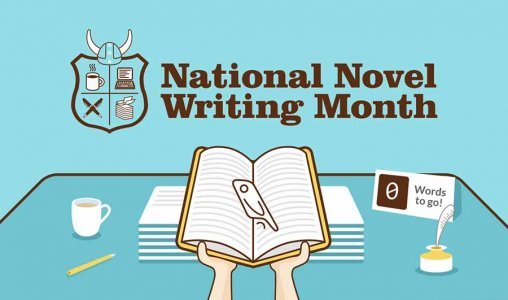 But writers also know that in between the rewrites you need to regenerate your imagination and your body. I like to play my guitar—I’m working on building those old calluses again. And my piano too, even if it’s only to tickle the ivories for a few minutes. Walk every day with Tom Claus (my hubby) and Ed, our ninety-three-year-old inspiration, and ballroom dance with my instructor, Henry, sometimes with Tom, that’s the best, really gets my heart pumping. And of course, Tom gives me flowers to inspire me as I write.
But writers also know that in between the rewrites you need to regenerate your imagination and your body. I like to play my guitar—I’m working on building those old calluses again. And my piano too, even if it’s only to tickle the ivories for a few minutes. Walk every day with Tom Claus (my hubby) and Ed, our ninety-three-year-old inspiration, and ballroom dance with my instructor, Henry, sometimes with Tom, that’s the best, really gets my heart pumping. And of course, Tom gives me flowers to inspire me as I write.
Oh, was I talking about writing?
My work-in-progress or WIP, The Unforgettable Miss Baldwin has taken about two years (and counting). One day at a time, one scene at a time. I am also constantly reading one of my hundreds, but who’s counting, craft books, like all those Thesaurus books and Emotional Beats by Nicholas C. Rossis. Which sometimes sends me down a different path in my writing. I will let you know when my Gilded Age Mistresses: The Unforgettable Miss Baldwin is ready for you.
I will be delirious when I type THE END.
Gail Ingis Claus is an author, artist/painter and interior designer. Her upcoming romance The Unforgettable Miss Baldwin will be released in spring 2018. Her current historical romance, Indigo Sky can be purchased on amazon.

A work of art

October 25, 2018
‘Tis the Season For Hot Toddies

Image from Wikipedia
It slides down my throat with the greatest of ease. Ha! Who said that? That’s a fallacy. Mom made me drink it whenever I got sick. Yuk. Her recipe was unique, hot water, tea, honey, whiskey, and milk. It was the worst. I got better fast. I had no choice. If I didn’t get better fast, I had to drink another and another. Horrors.
Here are the details, without milk, according to Wikipedia:
It’s called a hot toddy, also hot totty and hot tottie as well as hot whiskey in Ireland. It is typically a mixed drink made of liquor and water with sugar and spices and served hot. Hot toddy recipes vary and are traditionally drank before going to bed, or in wet or cold weather. Some believe the drink relieves the symptoms of the cold and flu — in How to Drink, Victoria Moore describes it as “the vitamin C for health, the honey to soothe, the alcohol to numb.”
Preparation
Traditional Scottish preparation of a hot toddy involves the mixture of whiskey, boiling water and sugar or honey. Additional ingredients such as cloves, a lemon slice or cinnamon (in stick or ground form) may be added.
The Irish version, hot whiskey, generally uses Irish whiskey, brown sugar, a lemon slice with cloves, and hot water.
A common version in the Midwestern United States uses Vernors Ginger Ale, lemon, honey and Bourbon whiskey. In Wisconsin, brandy is often used instead of bourbon.
A common version in Ontario typically consists of heated ginger-ale, honey, and either whiskey or brandy. It is often recommended to heat the ginger-ale before adding the whiskey or brandy, otherwise, the heating process will reduce the alcoholic effects of the liquor.

Image from Irish American Mom
Hot Irish Whiskey
“My best friend who just happens to be Irish made this drink for me one cold night in Chicago and since then, I have been hooked! Warning: it is very potent, just one of these will warm you up and basically make you good for nothing afterward – what a treat! It is super to drink at night if you have a sore throat. My friend said this is what the Irish drink if they don’t feel good but don’t wait until you have a cold to try this recipe!”
Ingredients for one drink
Recipe by Trinka G
8 whole cloves
1 (1/4 inch thick) slice of lemon
1 tablespoon white sugar
3/4 cup boiling water
1 (1.5 fluid ounce) jigger Irish whiskey
I did not know that whiskey, when heated, reduces its numbing effectiveness. Did you?
Grog is the name of a similar drink based on Rum in several cultures.
List of hot beverages
Tamagozake, the traditional Japanese cold cure, uses heated sake mixed with egg.
References
“Definition of Hot Toddy”. Princeton WordNet. Retrieved 12 February 2012.
Nigel Slater (March 13, 2011). “Nigel Slater’s classic hot toddy recipe”. The Guardian . Retrieved December 16, 2012.
“How to make a Hot Toddy”. LifeOverHere.com. January 3, 2012. Retrieved December 16, 2012.
“Wisconsin Winter Toddy”. Princeton WordNet. Retrieved 12 February 2012.
“Glossaries: India”. Lachlan and Elizabeth Macquarie Archive. Macquarie University. 2011. Retrieved December 16, 2012. Toddy: palm wine made from the sap of the palmyra palm.
“Hot Toddies”. Conan’s Pub. Retrieved December 16, 2012.
MacKay, Charles. A Dictionary of Lowland Scotch (1888)
Chicken soup made with love or hot toddy made with liquor . . . What’s your pick when you have a cold?
Gail Ingis Claus is an author, artist/painter and interior designer. Her upcoming romance The Unforgettable Miss Baldwin will be released in spring 2018. Her current historical romance, Indigo Sky can be purchased on amazon.

A work of art

October 18, 2018
Beating Heart of the City
New York City Hall, a beauty in classicism with its touch of Palladio! I studied interior design and architecture many moons ago, but my passion has not wained. New York City Hall is featured prominently in my upcoming book The Unforgettable Miss Baldwin. The cornerstone of City Hall was laid in 1803. Construction was delayed after the City Council objected that the design was too extravagant. In response, architects, McComb and Mangin reduced the size of the building and used brownstone at the rear of the building to lower costs. Labor disputes and an outbreak of yellow fever further slowed construction. The building was not dedicated until 1811 and opened officially in 1812. The original skin of the building, Massachusetts marble facade, quarried from Alford, Massachusetts, deteriorated and was replaced with Alabama limestone in 1954 to 1956.

City Hall, Park Row and City Hall Park, 1911. The structure on the right is the Manhattan station for the cable cars which ran across the Brooklyn Bridge
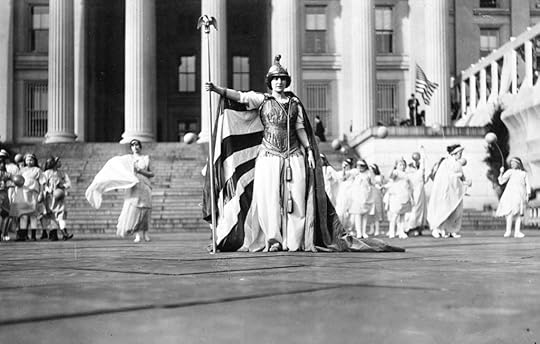
Steps of City Hall
The steps of City Hall frequently provide a backdrop for political demonstrations and press conferences concerning city politics. The heroine in my book meets the hero on the grounds of those steps while attending a women’s suffrage rally in 1886.
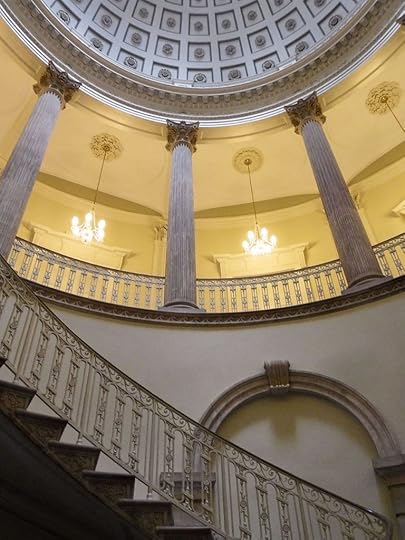
Rotunda
On the inside, the rotunda is a soaring space with a grand marble stairway rising up to the second floor, where ten fluted Corinthian columns support the coffered dome, which was added in a 1912 restoration by Grosvenor Atterbury. The rotunda has been the site of municipal as well as national events. Abraham Lincoln and Ulysses S. Grant lay in state there in 1865, attracting enormous crowds to pay their respects. City Hall is a designated New York City landmark. It is listed on the New York State and National Registers of Historic Places.
The area around City Hall is commonly referred to as the Civic Center. Most of the neighborhood consists of government offices (city, state and federal), as well as an increasing number of upscale residential dwellings being converted from older commercial structures. Architectural landmarks such as St. Paul’s Chapel, St. Peters Church, the Woolworth Building, Tweed Courthouse, the Manhattan Municipal Building, the Park Row Building, One Police Plaza, and the Brooklyn Bridge surround City Hall. If you’ve ever watched an episode of Law and Order, you’ll know what I’m talking about. Until next time, Gail.
Thank you, Wikipedia for the facts and links.
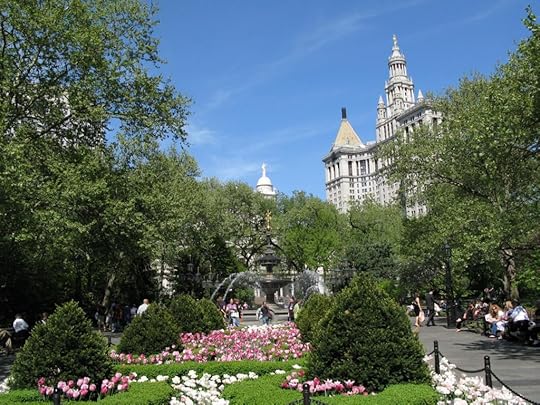
City Hall Park
Gail Ingis Claus is an author, artist/painter and interior designer. Her upcoming romance The Unforgettable Miss Baldwin will be released when she’s done revising, I’ll keep you in the know. Her current historical romance, Indigo Sky can be purchased on Amazon.


